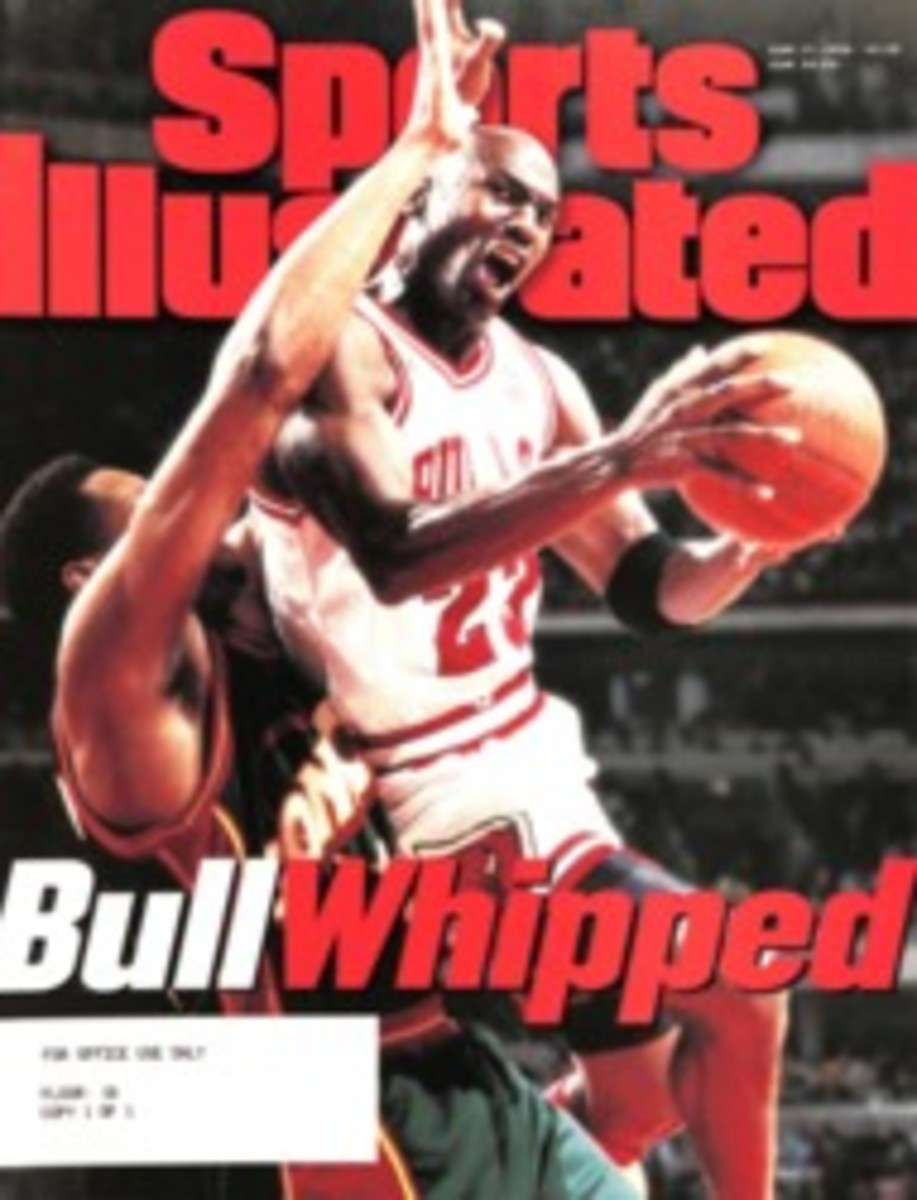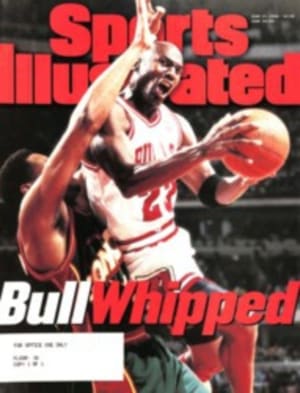
SHOW STOPPERS COLORADO, A DYNASTY IN THE MAKING, SWEPT FLORIDA TO WIN THE STANLEY CUP
The clock struck at 1:05 a.m. on Tuesday for Cinderella. A shot
from inside the blue line by Colorado Avalanche defenseman Uwe
Krupp at 4:31 of the third overtime sneaked past Florida
Panthers goalie John Vanbiesbrouck and ended the third-longest
game in Stanley Cup finals history, 1-0, and the fairy-tale
hopes of Florida, four games to none. Someday the Panthers might
live happily ever after, but it is the Avalanche who should live
well at the top of the NHL for many years to come. As the
Stanley Cup was handed to Joe Sakic, the Colorado captain and
playoff MVP, he pumped it over his head in ecstasy. "I never
knew what this meant," Sakic said. "This is the greatest moment
of my life."
Of course, the Avalanche had already been given a sneak preview
back at Denver's McNichols Arena, where Stanley Cups made of
aluminum foil had dotted the stands during Games 1 and 2. Like
Christmas decorations, those fake Cups should be carefully
stored for use next year, and the year after and the year after
that. The Avalanche players shudder at being labeled a budding
dynasty. O.K., let's just say that playing for the Stanley Cup
is going to become an annual event in Colorado, like spring
skiing and 39th birthdays. The playoff parity that has developed
in the last four seasons could be blown away by the Avalanche,
the NHL's next dominant team, a compelling blend of veterans and
bright, brassy young talent.
Four of Colorado's core players--22-year-old Peter Forsberg,
one of the league's most complete centers; 21-year-old Adam
Deadmarsh, soon to be a premier power forward; daring
23-year-old defenseman Sandis Ozolinsh, who plays from crease to
crease and often gives both teams an excellent chance to win;
and hard-hitting 24-year-old defenseman Adam Foote--are barely
old enough to grow decent playoff whiskers. High-scoring center
Sakic, a survivor of the Avalanche's dark days as the Quebec
Nordiques, is only 26. The Colorado graybeards are Bluebeard
himself, nasty right wing Claude Lemieux, and steady defenseman
Krupp, both of whom are 30 but have plenty of mileage left. Even
St. Patrick Roy, who drove the rats out of Miami, is just 30. "I
was talking to the trainer, and we were wondering how old
Ozolinsh was," said Roy, who allowed four goals in the finals.
"He's 23. Twenty-three. That's scary. Deadmarsh already is a
big-time player at 21. These young guys are just learning how to
win. This team could be dangerous."
Even as Colorado has ascended, most of its competition has begun
to slide. The profligate Detroit Red Wings have squandered their
great talent, the New York Rangers are old enough to get 10% off
on prescriptions, and the Pittsburgh Penguins' future rests on
the vagaries of Mario Lemieux's desire and health. "The
difference between Colorado and its supposed challengers like
Detroit and Pittsburgh is that Colorado's skill players are
young," says Florida president Bill Torrey, the architect of the
New York Islanders teams that won the Cup four times from 1980
to '83. "Colorado's got good size, speed and balance in scoring.
The Avalanche explodes, and that's what happens with a good team."
The challenge will be keeping together a team that already has a
$20 million payroll in this era of high salaries, increased free
agency and short attention spans, but even that task doesn't
seem especially daunting. With the proposed Pepsi Center inching
closer to a groundbreaking, Colorado figures to have a new home
for the 1998-99 season. The increased revenue from the new
arena--in ticket sales, luxury-box leases and so on--is expected
to generate enough money to keep the nucleus of the Avalanche
intact, with a little left over to pay coach Marc Crawford.
According to a Colorado source, Avalanche general manager Pierre
Lacroix figured any coach could have led a team this skilled to
the conference finals. By coaching Colorado to a semifinal
victory over the favored Red Wings, however, the 35-year-old
Crawford proved that he's an indispensable part of the team.
Avalanche president Charlie Lyons said last week that Crawford,
who has one year left on a contract that pays him only $160,000
a season, deserves an extension.
Crawford seemed to cope with the pressures of the Stanley Cup
finals better than Panthers coach Doug MacLean, who, like
Florida's rats-to-riches story, started to unravel even before
Game 1. Three minutes before the Panthers were to take the ice
at McNichols for the series opener, MacLean engaged in a
screaming match via walkie-talkie with NHL senior vice president
Brian Burke. Moments earlier the league's supervisor of
officials, Bryan Lewis, had ordered Vanbiesbrouck to put white
adhesive tape over the knob of his stick in accordance with a
rule as widely unenforced as it is arcane. (The
color-coordinated Vanbiesbrouck had been using red tape on the
stick butt for three years.) Rule No. 3001 B.C., Vanbiesbrouck
called it the next day, and newspapers dubbed the incident
Knobgate, though at issue was only five inches of tape, not 18
minutes of it.
Backup officials had spotted the offending knob from the stands
during warmups, but Panthers executives thought they smelled a
Colorado rat. They intimated that the Avalanche had somehow
orchestrated the tape crackdown in an effort to upset
Vanbiesbrouck, whose game-day concentration makes him look like
a Stepford husband. (Once when Florida owner Wayne Huizenga
tapped him on the shoulder to wish him luck before a start,
Vanbiesbrouck responded with the kind of elbow rarely thrown at
employers.) When an ashen-faced trainer relayed the stick-taping
order to him, Vanbiesbrouck was miffed, but if the news rattled
him, its effects were tape-delayed. He shut out Colorado for
half the game before the Avalanche pumped three second-period
goals past him in a stretch of 3:49 and went on to a 3-1 victory.
Tales of the tape did not catch MacLean's eye the next day as
much as a column in the Denver Post that assailed the Panthers'
conservative play. The article was more uninformed, cartoonish
and vituperative than some of the others published in newspapers
in cities around the NHL that have dumped on Florida's
style--and the timing was right--so MacLean chose to use it as a
motivational tool. He had the column photocopied and placed in
every Panther's locker. Florida was so inspired by this high
school psychology that the Panthers incurred a rash of bad
penalties, allowed three power-play goals in the first period
and absorbed an 8-1 beating, the second-worst in Stanley Cup
finals history.
Throughout a fairy-tale season Florida had prided itself on
being a group of ordinary, hardworking players, and now, in the
glare of the finals, they had been exposed as nothing more than
what they had pretended to be. When the prop of excellent
goaltending was removed--Vanbiesbrouck, who was yanked after the
first period in Game 2, couldn't outplay Roy--the Panthers'
facade crumbled. Florida's effort was beyond reproach, except
in Game 2, but its thin talent was overwhelmed by Colorado's
lineup, especially by Forsberg and Sakic.
Roy says that someday, when he retires, "I'll be able to say
Peter and Joe were the best forwards I ever played with." In 10
seasons with the Montreal Canadiens, during which time he played
on two Stanley Cup-winning teams, Roy didn't have a teammate who
could shape a game the way Sakic and Forsberg can. Sakic, the
captain, has dazzling acceleration and a laser that masquerades
as a wrist shot. Forsberg offers size--he's 6 feet and 190
pounds--creativity, toughness and an ability to play well in
traffic.
Both are sparing with words. When asked to characterize a
typical Sakic dressing-room oration, Colorado defenseman Craig
Wolanin offered this impersonation: "O.K., guys, the bus is
leaving at noon." Forsberg seems to have inherited his reticence
from his dad, Kent, who coached him on the MoDo club of the
Swedish Elite league a few years ago and who will coach him
again on Sweden's team at the World Cup this summer. When Kent
was asked last week at what point he realized Peter was a
special player, he said, "I don't know that he is special. He's
only been in this league 1 1/2 years. When he's been around four
or five years, then we'll know if he's a star."
Anyone else doubting that the younger Forsberg is indeed special
need only rewind the finals tape to Peter's first-period hat
trick in Game 2. Goal No. 1: rebounds his own shot off Florida
defenseman Rhett Warrener's stick and nudges the puck past
Vanbiesbrouck. Goal No. 2: drills heavy wrist shot from the left
face-off circle and beats Vanbiesbrouck on the glove side. Goal
No. 3: bats a letter-high knuckleball that has caromed off the
backboards into the net with a lefthanded swing as sweet as any
the Rockies' Larry Walker has taken lately. Three goals, three
ways. "Good to see him shoot," teammate Mike Keane says. "He's a
typical Swede in that he wants to make the nice plays all the
time and sometimes overpasses." There's the weakness of
Forsberg's game: altruism. "But he's also strong on his skates
and the toughest European I've ever seen," adds Keane.
Indeed, Kent says that in Sweden, Peter had been considered too
tough at times. In 1991, during Peter's second season with MoDo,
an article lamenting the rough play of Peter and linemate Markus
Naslund appeared in a national daily, Aftonbladet, under the
headline: THEY MUST BE STOPPED!
Forsberg had an assist in Game 3 against Florida, playing 21
minutes and dominating the 3-2 win with his all-around effort.
Sakic scored the game-winner--his record sixth decisive goal of
the playoffs--early in the second period on a two-on-one. And
Roy came on strong after a shaky first period, during which he
endured two rat showers provided by the Miami Arena fans. Maybe
the rest of the hockey world wishes Florida right wing Scott
Mellanby, who started the rat craze by killing one in the
dressing room at the Panthers' arena on opening night, had
simply caught the rodent and rehabilitated it, but not Roy.
"Thank god they scored two goals," Roy, at his most charmingly
arrogant, said after the game. "Those fans would have left with
all those rats in their pockets. I would have been sad for them."
Roy, who was superb in making 63 saves during his 1:44:31 of
shutout goaltending in Game 4, gave them no chance to celebrate
on Tuesday morning.
COLOR PHOTO: DAVID E. KLUTHO Bowled Over That's what the Panthers were in Game 2 of the Stanley Cup finals, when the Avalanche's four quick goals forced Florida to bring in relief goalie Mark Fitzpatrick, here stretching before allowing four more Colorado goals (page 50). [T of C]
COLOR PHOTO: DAVID E. KLUTHO The all-but-impregnable Roy frustrated Tom Fitzgerald and Florida in a 3-2 Game 3 win. [Patrick Roy attempting to block shot by Florida Panthers player]
COLOR PHOTO: TIM DEFRISCO After being shut out in Game 1, playoff MVP Sakic had four assists in Colorado's 8-1 Game 2 rout. [Joe Sakic]
COLOR PHOTO:BILL FRAKES Roy, who lifted his mates with 63 saves in an epic Game 4, got to hoist the Cup for the third time. [Patrick Roy holding Stanley Cup]

